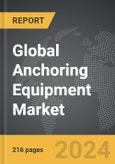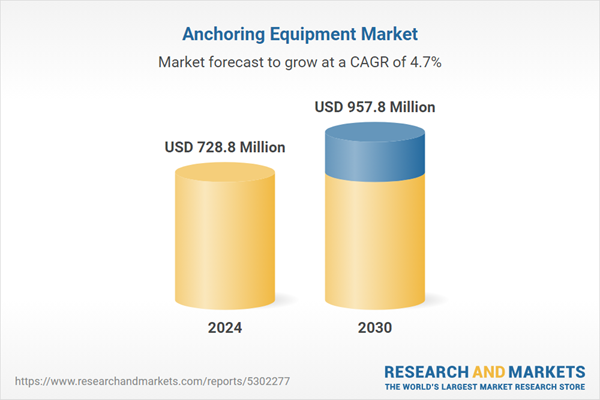The global market for Anchoring Equipment was valued at US$728.8 Million in 2024 and is projected to reach US$957.8 Million by 2030, growing at a CAGR of 4.7% from 2024 to 2030. This comprehensive report provides an in-depth analysis of market trends, drivers, and forecasts, helping you make informed business decisions. The report includes the most recent global tariff developments and how they impact the Anchoring Equipment market.
Technological advancements have significantly influenced the development and performance of anchoring equipment in the construction industry. Modern anchoring solutions are made from high-strength materials such as stainless steel and specially treated alloys that offer superior corrosion resistance and durability. Innovations in anchor design have led to improved load distribution and higher load-bearing capacities, which enhance the overall safety and longevity of structures. For example, the development of high-performance adhesive anchors has revolutionized anchoring in seismic zones, providing reliable solutions that can withstand dynamic loads and vibrations. Automated installation tools and methods, such as robotic drilling and anchoring systems, further improve precision and reduce installation time, making the construction process more efficient and cost-effective.
The growth in the anchoring equipment market is driven by several factors, including the increasing complexity of modern construction projects, advancements in construction technologies, and the growing emphasis on safety and regulatory compliance. The rise of large-scale infrastructure projects, such as high-rise buildings, bridges, and tunnels, necessitates advanced anchoring solutions capable of supporting substantial loads and ensuring structural integrity. Technological advancements, such as the development of innovative materials and automated installation techniques, have expanded the capabilities and applications of anchoring equipment. The construction industry's focus on safety and adherence to stringent building codes and standards also drives the demand for reliable and high-performance anchoring systems. Moreover, the increasing adoption of green building practices and sustainable construction methods requires anchoring solutions that not only provide structural stability but also have minimal environmental impact. These drivers collectively contribute to the robust expansion of the anchoring equipment market, ensuring its continued evolution and significance in the construction industry.
Segments: Type (Strand Anchor, Drill Hollow Bar, Thread Bar, Other Types).
Geographic Regions/Countries: World; USA; Canada; Japan; China; Europe; France; Germany; Italy; UK; Spain; Russia; Rest of Europe; Asia-Pacific; Australia; India; South Korea; Rest of Asia-Pacific; Latin America; Argentina; Brazil; Mexico; Rest of Latin America; Middle East; Iran; Israel; Saudi Arabia; UAE; Rest of Middle East; Africa.
The analysts continuously track trade developments worldwide, drawing insights from leading global economists and over 200 industry and policy institutions, including think tanks, trade organizations, and national economic advisory bodies. This intelligence is integrated into forecasting models to provide timely, data-driven analysis of emerging risks and opportunities.
Global Anchoring Equipment Market - Key Trends & Drivers Summarized
Anchoring equipment in the construction industry plays a critical role in ensuring the stability and safety of structures, both during and after the construction process. Civil engineering structures, such as dams, bridges, and tunnels, play a crucial role in meeting the growing energy demand along with achieving extensive interconnectivity within cities as well as regions. For constructing such structures, vast amounts of soil needs to be excavated or displaced from either above or below the ground, which requires various specialized devices, such as anchoring equipment; soil retention systems, such as pipe piles and piling sheets; and trench shoring systems, such as pullers, pipe grabbers, trench boxes, and slide rails, for ensuring safety and structural stability of the adjoining soil structure. One of the major advantages of anchors in comparison to strut frames is that they allow the construction pit to remain obstacle free.Technological advancements have significantly influenced the development and performance of anchoring equipment in the construction industry. Modern anchoring solutions are made from high-strength materials such as stainless steel and specially treated alloys that offer superior corrosion resistance and durability. Innovations in anchor design have led to improved load distribution and higher load-bearing capacities, which enhance the overall safety and longevity of structures. For example, the development of high-performance adhesive anchors has revolutionized anchoring in seismic zones, providing reliable solutions that can withstand dynamic loads and vibrations. Automated installation tools and methods, such as robotic drilling and anchoring systems, further improve precision and reduce installation time, making the construction process more efficient and cost-effective.
The growth in the anchoring equipment market is driven by several factors, including the increasing complexity of modern construction projects, advancements in construction technologies, and the growing emphasis on safety and regulatory compliance. The rise of large-scale infrastructure projects, such as high-rise buildings, bridges, and tunnels, necessitates advanced anchoring solutions capable of supporting substantial loads and ensuring structural integrity. Technological advancements, such as the development of innovative materials and automated installation techniques, have expanded the capabilities and applications of anchoring equipment. The construction industry's focus on safety and adherence to stringent building codes and standards also drives the demand for reliable and high-performance anchoring systems. Moreover, the increasing adoption of green building practices and sustainable construction methods requires anchoring solutions that not only provide structural stability but also have minimal environmental impact. These drivers collectively contribute to the robust expansion of the anchoring equipment market, ensuring its continued evolution and significance in the construction industry.
Report Scope
The report analyzes the Anchoring Equipment market, presented in terms of units. The analysis covers the key segments and geographic regions outlined below.Segments: Type (Strand Anchor, Drill Hollow Bar, Thread Bar, Other Types).
Geographic Regions/Countries: World; USA; Canada; Japan; China; Europe; France; Germany; Italy; UK; Spain; Russia; Rest of Europe; Asia-Pacific; Australia; India; South Korea; Rest of Asia-Pacific; Latin America; Argentina; Brazil; Mexico; Rest of Latin America; Middle East; Iran; Israel; Saudi Arabia; UAE; Rest of Middle East; Africa.
Key Insights:
- Market Growth: Understand the significant growth trajectory of the Strand Anchor segment, which is expected to reach US$479.1 Million by 2030 with a CAGR of a 5.2%. The Drill Hollow Bar segment is also set to grow at 4.4% CAGR over the analysis period.
- Regional Analysis: Gain insights into the U.S. market, valued at $161.6 Million in 2024, and China, forecasted to grow at an impressive 6.0% CAGR to reach $195.6 Million by 2030. Discover growth trends in other key regions, including Japan, Canada, Germany, and the Asia-Pacific.
Why You Should Buy This Report:
- Detailed Market Analysis: Access a thorough analysis of the Global Anchoring Equipment Market, covering all major geographic regions and market segments.
- Competitive Insights: Get an overview of the competitive landscape, including the market presence of major players across different geographies.
- Future Trends and Drivers: Understand the key trends and drivers shaping the future of the Global Anchoring Equipment Market.
- Actionable Insights: Benefit from actionable insights that can help you identify new revenue opportunities and make strategic business decisions.
Key Questions Answered:
- How is the Global Anchoring Equipment Market expected to evolve by 2030?
- What are the main drivers and restraints affecting the market?
- Which market segments will grow the most over the forecast period?
- How will market shares for different regions and segments change by 2030?
- Who are the leading players in the market, and what are their prospects?
Report Features:
- Comprehensive Market Data: Independent analysis of annual sales and market forecasts in US$ Million from 2024 to 2030.
- In-Depth Regional Analysis: Detailed insights into key markets, including the U.S., China, Japan, Canada, Europe, Asia-Pacific, Latin America, Middle East, and Africa.
- Company Profiles: Coverage of players such as Aarti Steels Ltd, Anchor Systems (International) Ltd., Ancor LOC New Zealand Ltd., Anker System Malinin, ANP - Systems GmbH and more.
- Complimentary Updates: Receive free report updates for one year to keep you informed of the latest market developments.
Some of the 30 companies featured in this Anchoring Equipment market report include:
- Aarti Steels Ltd
- Anchor Systems (International) Ltd.
- Ancor LOC New Zealand Ltd.
- Anker System Malinin
- ANP - Systems GmbH
- BAUER Engineering India Pvt. Ltd.
- BBR VT International Limited
- BBV SYSTEMS CO., LTD.
- BrandSafway
- Con-Tech Systems Ltd.
Tariff Impact Analysis: Key Insights for 2025
Global tariff negotiations across 180+ countries are reshaping supply chains, costs, and competitiveness. This report reflects the latest developments as of April 2025 and incorporates forward-looking insights into the market outlook.The analysts continuously track trade developments worldwide, drawing insights from leading global economists and over 200 industry and policy institutions, including think tanks, trade organizations, and national economic advisory bodies. This intelligence is integrated into forecasting models to provide timely, data-driven analysis of emerging risks and opportunities.
What’s Included in This Edition:
- Tariff-adjusted market forecasts by region and segment
- Analysis of cost and supply chain implications by sourcing and trade exposure
- Strategic insights into geographic shifts
Buyers receive a free July 2025 update with:
- Finalized tariff impacts and new trade agreement effects
- Updated projections reflecting global sourcing and cost shifts
- Expanded country-specific coverage across the industry
Table of Contents
I. METHODOLOGYII. EXECUTIVE SUMMARY2. FOCUS ON SELECT PLAYERSIII. MARKET ANALYSISIV. COMPETITION
1. MARKET OVERVIEW
3. MARKET TRENDS & DRIVERS
4. GLOBAL MARKET PERSPECTIVE
UNITED STATES
CANADA
JAPAN
CHINA
EUROPE
FRANCE
GERMANY
ITALY
UNITED KINGDOM
SPAIN
RUSSIA
REST OF EUROPE
ASIA-PACIFIC
AUSTRALIA
INDIA
SOUTH KOREA
REST OF ASIA-PACIFIC
LATIN AMERICA
ARGENTINA
BRAZIL
MEXICO
REST OF LATIN AMERICA
MIDDLE EAST
AFRICA
Companies Mentioned (Partial List)
A selection of companies mentioned in this report includes, but is not limited to:
- Aarti Steels Ltd
- Anchor Systems (International) Ltd.
- Ancor LOC New Zealand Ltd.
- Anker System Malinin
- ANP - Systems GmbH
- BAUER Engineering India Pvt. Ltd.
- BBR VT International Limited
- BBV SYSTEMS CO., LTD.
- BrandSafway
- Con-Tech Systems Ltd.
Table Information
| Report Attribute | Details |
|---|---|
| No. of Pages | 216 |
| Published | April 2025 |
| Forecast Period | 2024 - 2030 |
| Estimated Market Value ( USD | $ 728.8 Million |
| Forecasted Market Value ( USD | $ 957.8 Million |
| Compound Annual Growth Rate | 4.7% |
| Regions Covered | Global |









